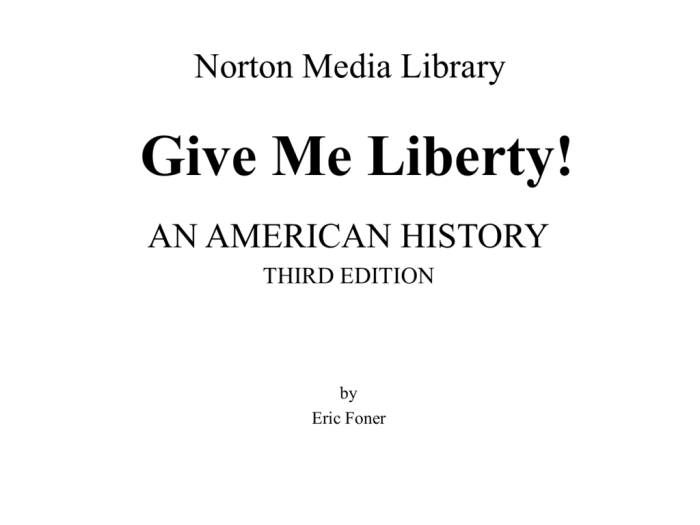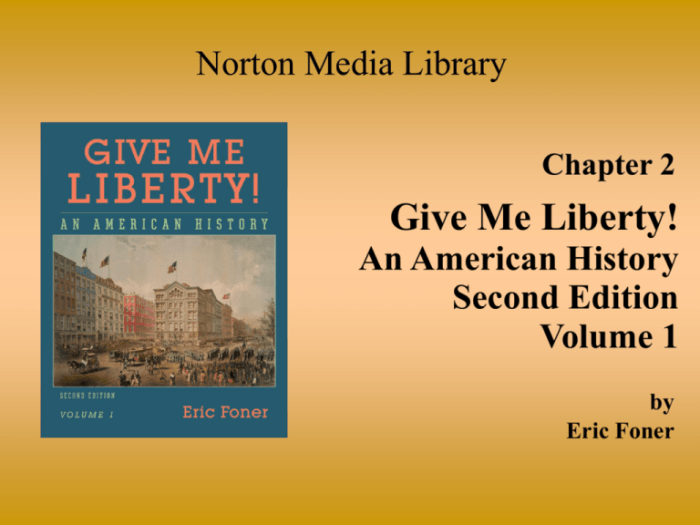Chapter 14 give me liberty – Chapter 14: Give Me Liberty embarks on a captivating exploration of the American Revolution and its profound impact on the concept of liberty. Set against a backdrop of political upheaval and social transformation, this chapter delves into the struggles and aspirations of individuals seeking independence and self-governance.
Through the lens of compelling characters and evocative symbolism, Chapter 14 invites readers to witness the birth of a nation and the enduring legacy of its founding principles.
Historical Context
The American Revolution and the Declaration of Independence are pivotal events in understanding Chapter 14. The revolution was a struggle for independence from British rule, while the Declaration of Independence proclaimed the thirteen American colonies’ freedom from Great Britain.
The political and social climate leading up to these events was marked by growing tensions between the colonies and Britain. The British imposed taxes and regulations that the colonists considered unjust, leading to protests and resistance. Key figures involved included George Washington, Thomas Jefferson, and Benjamin Franklin.
British Colonial Policy
- Enacted the Stamp Act, which imposed taxes on paper goods.
- Passed the Townshend Acts, which imposed duties on imported goods.
- Issued the Tea Act, which gave the British East India Company a monopoly on tea sales in the colonies.
Colonial Resistance
- Organized protests and boycotts against British goods.
- Formed committees of correspondence to coordinate resistance efforts.
- Engaged in armed conflict with British troops, leading to the Battle of Lexington and Concord.
Key Figures
- George Washington:Commander-in-chief of the Continental Army.
- Thomas Jefferson:Author of the Declaration of Independence.
- Benjamin Franklin:Diplomat and inventor who secured French support for the American cause.
Major Themes

Chapter 14 of “Give Me Liberty!” explores several central themes, including liberty, independence, and self-governance. These themes are developed through the actions and interactions of the characters as they navigate the challenges of establishing a new nation.
Liberty
Liberty is a central theme throughout the chapter. The characters grapple with the concept of liberty, both as individuals and as a collective. They debate the extent to which individual rights should be protected, and they struggle to balance the need for order with the desire for freedom.
Independence
Independence is another major theme in Chapter 14. The characters are faced with the challenge of creating a new nation that is independent from Great Britain. They must learn to govern themselves and to make decisions that are in the best interests of their new country.
Self-Governance
Self-governance is a key theme in Chapter 14. The characters must learn to govern themselves and to make decisions that are in the best interests of their new country. They must also learn to balance the need for order with the desire for freedom.
Character Analysis

Elizabeth Campbell, a central figure in Chapter 14, emerges as a complex and enigmatic character. Her motivations, beliefs, and actions drive the narrative, shaping the events that unfold.
Elizabeth Campbell
Elizabeth is a woman of strong convictions, driven by a desire for freedom and independence. She challenges societal norms, defying the expectations placed upon women of her time. Her beliefs in the equality of all people and the right to self-determination motivate her actions throughout the chapter.
Elizabeth’s determination is evident in her interactions with John McNair. Despite his initial resistance, she persuades him to join her in her quest for freedom. Her ability to inspire others speaks to her charisma and leadership qualities.
John McNair
John McNair, a former slave, plays a pivotal role in the events of Chapter 14. His relationship with Elizabeth Campbell is complex, marked by both admiration and conflict. He is drawn to her ideals but struggles to reconcile them with his own experiences of oppression.
McNair’s initial reluctance to join Elizabeth’s cause stems from his skepticism about the possibility of achieving true freedom for enslaved people. However, Elizabeth’s unwavering belief and determination gradually sway him, leading him to embrace her vision.
Other Significant Characters
In addition to Elizabeth Campbell and John McNair, several other significant characters contribute to the narrative of Chapter 14:
- Elijah Lovejoy:A white abolitionist who provides support and resources to Elizabeth’s group.
- William Whipper:A free Black man who assists Elizabeth in her escape from slavery.
- Samuel Blackwell:A Quaker who helps Elizabeth and her group settle in Canada.
These characters represent different perspectives and experiences within the abolitionist movement, highlighting the diverse coalition of individuals who fought for freedom.
Symbolism and Imagery
Chapter 14 of “Give Me Liberty!” employs rich symbolism and vivid imagery to convey the chapter’s themes and develop its characters.
The Liberty Tree, a prominent symbol throughout the chapter, represents the colonists’ aspirations for freedom and self-governance. Its branches provide a meeting place for the Sons of Liberty, symbolizing the unity and strength of the colonists in their struggle against British oppression.
The Eagle
The eagle, another significant symbol, appears as a representation of American independence and power. Its soaring flight embodies the colonists’ aspirations to break free from British rule and establish a new nation.
The Setting
The chapter’s setting, a bustling Boston on the eve of the American Revolution, plays a crucial role in shaping the events and characters. The city’s crowded streets and lively taverns provide a backdrop for the colonists’ growing discontent and their determination to fight for their rights.
Literary Techniques
In Chapter 14, the author employs a variety of literary techniques to enhance the reader’s engagement with the narrative. These techniques include foreshadowing, irony, suspense, and figurative language, each contributing to the chapter’s overall tone and atmosphere.
Foreshadowing
Foreshadowing is used to hint at events that will occur later in the story. In Chapter 14, the author foreshadows the upcoming battle between the colonists and the British by describing the growing tensions between the two groups. For example, the author writes, “The air was thick with tension, and everyone could feel that something was about to happen.”
This foreshadowing creates a sense of anticipation and suspense, keeping the reader engaged in the narrative.
Irony
Irony is used to create a contrast between what is expected and what actually happens. In Chapter 14, the author uses irony to highlight the colonists’ lack of preparation for war. For example, the author writes, “The colonists had been talking about fighting for their freedom for years, but when the time came, they were woefully unprepared.”
This irony adds a layer of complexity to the narrative, making the reader question the colonists’ motives and abilities.
Suspense
Suspense is used to create a feeling of uncertainty and tension in the reader. In Chapter 14, the author uses suspense to keep the reader guessing about the outcome of the upcoming battle. For example, the author writes, “The battle raged on, and it was impossible to tell who would win.”
This suspense keeps the reader engaged in the narrative, eager to learn what will happen next.
Chapter 14 “Give Me Liberty” underscores the importance of freedom and independence. Similarly, the cinco de mayo escape room celebrates the Mexican victory over the French in 1862, a testament to the power of a united people fighting for their liberty.
Chapter 14 further explores the sacrifices and struggles necessary to achieve freedom, reminding us of the eternal pursuit of autonomy.
Figurative Language
Figurative language is used to create a vivid and memorable impression in the reader’s mind. In Chapter 14, the author uses figurative language to describe the battle between the colonists and the British. For example, the author writes, “The battle was a whirlwind of smoke and fire, and the air was filled with the screams of the wounded.”
This figurative language helps the reader to visualize the chaos and violence of the battle, creating a more immersive and impactful experience.
Historical Accuracy and Interpretation

Chapter 14 of “Give Me Liberty!” presents a dramatized account of historical events surrounding the American Revolution. While the author, Eric Foner, adheres closely to historical facts, he also employs creative license to enhance the narrative and convey the complexities of the period.
Foner’s portrayal of the Boston Tea Party, for instance, is generally accurate. The event occurred on December 16, 1773, and involved a group of colonists disguised as Mohawk Indians who boarded three British ships and dumped their tea cargo into Boston Harbor.
Foner’s account captures the audacity and defiance of the protesters, who were motivated by British taxation policies they deemed unjust.
Author’s Interpretation and Bias
However, Foner’s interpretation of these events is influenced by his perspective as a historian who specializes in the American Revolution. He presents the colonists’ actions as a justified response to British oppression, emphasizing the growing sense of frustration and resentment among the American populace.
Foner also highlights the role of class conflict in the Revolution, as many of the colonists who participated in the Tea Party were artisans and laborers who felt marginalized by the British ruling class.
Contribution to Understanding, Chapter 14 give me liberty
Chapter 14 contributes to our understanding of the American Revolution by providing a vivid and engaging account of key events. Foner’s dramatization helps readers connect with the human experiences and motivations that shaped the course of history. By exploring the complexities of the period, Foner challenges simplistic narratives and encourages readers to consider multiple perspectives.
Q&A: Chapter 14 Give Me Liberty
What is the significance of the Liberty Tree in Chapter 14?
The Liberty Tree serves as a powerful symbol of resistance and defiance against British rule, representing the colonists’ aspiration for freedom and self-determination.
How does Elizabeth Campbell embody the theme of liberty in Chapter 14?
Elizabeth Campbell’s unwavering determination to fight for her beliefs and her refusal to compromise her principles exemplify the spirit of liberty that permeates the chapter.
What are the key literary techniques employed in Chapter 14?
The author utilizes foreshadowing, irony, and suspense to create a gripping narrative that keeps readers engaged and enhances their understanding of the characters and events.